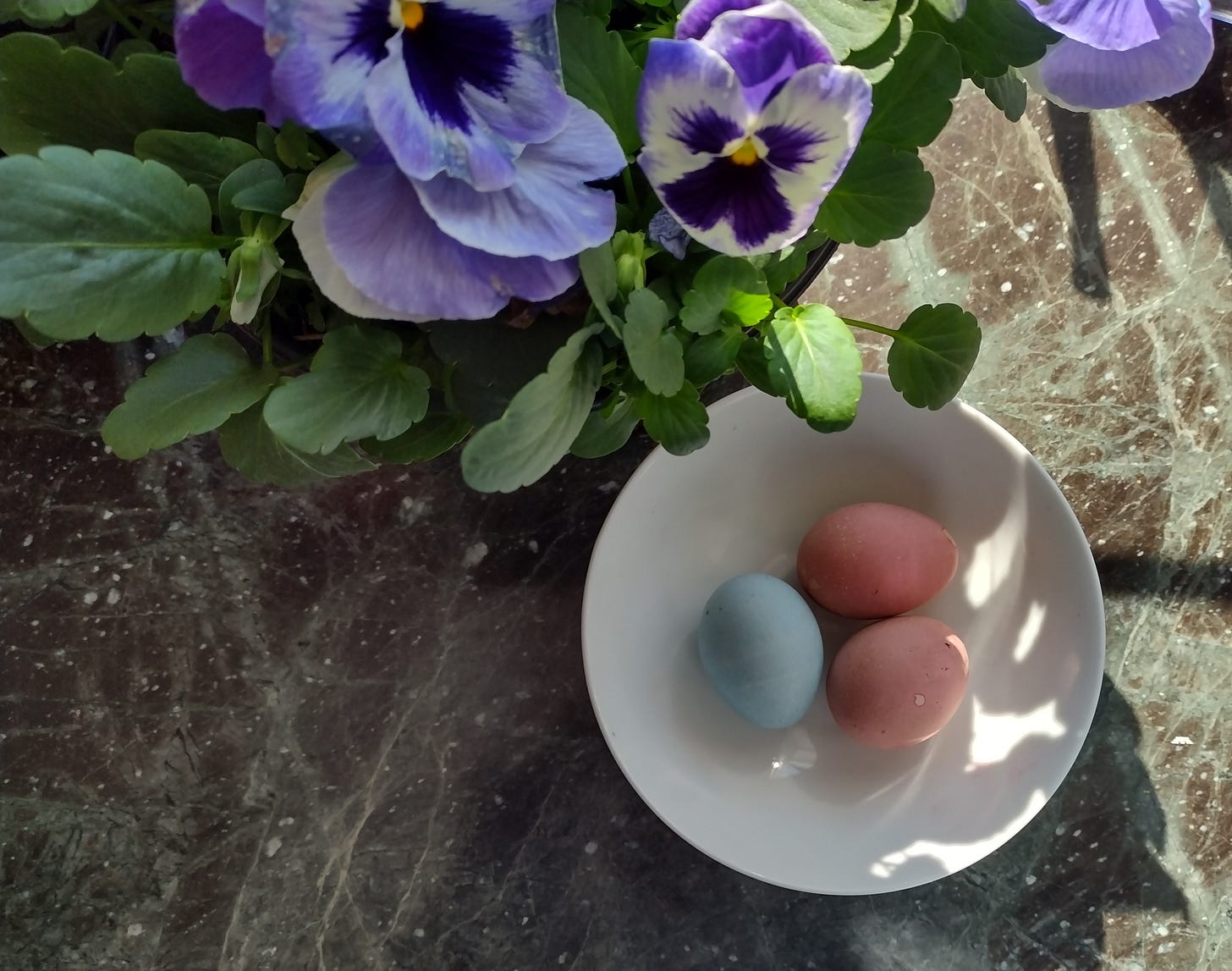Carrot cake was popular back in the 1970s when health food stores were popping up. It offered a hit of vitamin A and was perceived as being healthy compared to the bundt cake of the 60s. Its origin may date back to carrot pudding of medieval times when sweeteners were expensive and carrots were a substitute with their natural sugars according to carrotmuseum.co.uk. The popularity was also revived in Britain during World War II when white sugar was in short supply. Carrot cake is a throwback that seems to pair well with my little kitschy Easter bunny figurine. My husband presented her to me, after one of his stops at a yard sale in our town, as a joke, but I was quite taken with her crocs and basket of colored eggs and she has been on display ever since. Plus, her colors seem to compliment my landscapes. For some reason she makes me smile.
This recipe is one of my mother’s. I reduced the amount of sugar, used unsweetened coconut, and I topped the cake with a coconut cream frosting, that I discovered at EatingWell.com, instead of the more traditional cream cheese frosting. The coconut cream frosting is light, very easy to make and to apply.
Cake Ingredients
2 c. unbleached white flour
2 t. baking soda
1 t. baking powder
1 t. salt
2 t. cinnamon
1 c. sugar (my mom used 1 1/2)
3 eggs
1 t. vanilla
1 c. vegetable oil
1 c. unsweetened coconut
1 c. walnuts, chopped
1 8 1/2 oz. can crushed pineapple
2 c. shredded carrots
Directions
Preheat the oven to 350 degrees. Grease two round 8” cake pans.
In a large mixing bowl, sift together the dry ingredients. In a separate medium mixing bowl lightly beat the eggs. Add the vanilla, oil, coconut, nuts, pineapple, and carrots.
Stir well. Add the wet ingredients to the dry ingredients. Mix. Divide the batter evenly between the two prepared cake pans. Bake for 45-50 minutes or until the top of the cake springs back when lightly touched. Cool. Remove cake from pans.
Frosting Ingredients
1 14 oz. can unsweetened coconut cream
2 T. confectioner’s sugar
1/2 t. vanilla
Frosting Directions
Scoop out the thick cream at the top of the can and place in a small bowl. You will have about one cup. Set aside the liquid for another use. Add the sugar and vanilla. Beat with an electric mixer for three minutes on a low speed. Soft peaks will form. Place in the refrigerator for thirty minutes so that the frosting thickens. Ice your cake.
Easter Traditions
Natural Dyes for Eggs
My only experience with dying hard boiled eggs for Easter had been with using a Paas Egg Decorating Kit. This year I decided to play around with some natural food dyes. The pinkish eggs were colored in the same pot where I was boiling beets. I added the eggs to the pot for the last ten minutes of cooking. The blue egg was dyed in a pot where I decided to boil a small wedge of red cabbage that I was about to discard. I also added a tablespoon of white vinegar to the pot. I continued to let the egg soak in the blueish water after it had become hard-boiled and removed from the heat. Don’t be discouraged if initially your eggs do not appear to be taking on any color at all. After a couple of hours it turned this pretty, light blue. Continue to let your eggs soak for a richer, dark hue.
Happy Easter
Thanks for reading!
Vicki







David said Aunt Margie’s carrot cake was the best…will have to try it soon!
Happy Easter! 🐇
The cake looks so delicious and beautiful and I love the bunny with your landscape. Who knew there was an online carrot museum? Delightful read, Happy Easter, Vicki! 🥕🐇